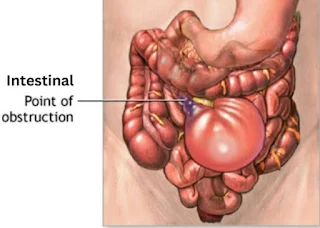Diseases of Intestine
Structure
of Intestine
Intestine is divided into two parts, small
intestine and large intestine.
Small
intestine
1.It is a 8 foot long tube. However due to
relaxation of its muscle after death,its length measure 20 to 21 feet at the
time of a postmortem examination.
2.It begins at the pyloric end of the
stomach and ends at the caecum.
3.It is divided into three parts.
.Duodenum
.Jejunum.
.Ileum.
4.It has four layers.
.Serosa:Outer layer of visceral peritoneum.
.Muscularis:Layer of smooth muscle under the serosa.
.Submucosa:Layer of loose connective tissue under the muscularis.
.Mucosa:Mucosa membrane lining the lumen of the intestine.
5.Undigested food is emptied into the large
intestine.
6.The following digestive juices are
emptied into the small intestine for digestive of food:-
Digestive
Juices
Emptied into Small Intestine
|
Source |
Digestive juice |
|
Liver and gall bladder |
Bile |
|
Pancreas |
Pancreatic juice. |
|
Small intestine |
Intestinal juice. |
Large
Intestine
1.It is a 5 feet long tube with a diameter
of 2.5”.
2.It extends from the end of ileum to the
anus.
3.It has the following parts:-
.Caecum.
.Colon.
.Rectum.
.Anal canal.
4.Caecum is in continuity with the end of
the ileum.Ileocaecal valve is found at the junction of the two.The appendix
tissue in the appendix protects from
infection.
5.The wall of large intestine is thicker
than that of the small intestine.There longitudinal bands of smooth muscle
along its outer surface called taenia coli.
6.There are small tags of fat attached to
its outer surface called appendices
epiploicae.
7.The taenia and appendices are not seen in
the wall of the rectum and anal canal.
8.At the lower end of the anal canal is the
anal sphincters, external and internal.
Function
|
Part of intestine |
Function |
|
Small intestine |
.Digestion of food. .Absorption of products of digestion of food. .Propulsion of undigested food to the large intestine for
excretion. |
|
Caecum |
.Receptacle at the beginning of the large intestine. .Asorption of water. |
|
Colon |
.Absorption of water so that solid stool is formed. .Absorption of electrolytes and glucose. .Propulsion of undigested food to the rectum for excretion. |
|
Appendix |
.Presence of large amount of lymphoid tissue protects from
infection. It is a vestigial organ.
|
|
Anal canal |
The anal sphincters prevent passage of stool until it socially
acceptable to pass stool. |
|
|
|
|
|
|
|
|
|
|
|
|
|
|
|
Symptoms
of Disturbance of Large Intestine
Abnormal Stool
Abdominal Colic.
Constipation.
Flatulence.
Diarrhoea.
Dysentry.
Observation
of Stools
|
Variable |
Normal |
Abnormalities Feature |
Cause |
|
Colour |
Light or dark brown |
Blackish |
.Green leafy vegetables. .Iron therapy. .Upper intestinal haemorrhage. |
|
|
|
Clay |
.Jaundice. |
|
|
|
Red |
.Blood in stools. |
|
|
|
Pea soup |
.Typhoid. |
|
|
|
Rice Water |
.Cholera. |
|
Odour |
Sour |
Foul |
.Indigestion. |
|
|
Obnoxious. |
Rotten fish |
.Pus in stools |
|
|
|
Dysentry |
.Sour. |
|
Volume |
10 to 12 oz |
Large |
.Greater high residue diet. |
|
Volume |
|
Low |
.Low residue diet. .Fasting,with only milk intake. |
|
Consistency |
Medium passed easily. |
Hard |
.Constipation. |
|
|
|
Liquid |
.Diarrhoea. |
|
|
|
Blood and mucus |
.Dysentery. |
|
|
|
Rice water |
.Cholera. |
|
|
|
Pea soup |
.Typhoid. |
|
|
|
Froth ,oily |
.Hepatitis. |
|
Frequency |
1/ 2 per day. |
>2 days |
.Constipation. |
|
|
|
>2 days |
.Diarrhoea,dysentery,colitis,cholera,indigestion. |
|
Reaction |
Slightly alkaline. |
Acid |
.Diarrhoea,dysentery. |
|
Defecation |
Painless |
Painful and difficult |
.Constipation .Fissure in ano. .Perianal abscess. .Prolapsed, thrombosed piles. |
|
|
|
With colic |
.Dysentry. .Gastroenteritis. |
|
Microscopy |
Undigested foodparticles |
Worms(round worm,hook worm,thread worm),eggs of worms,E .histolytica,blood,mucus. |
|
Abdominal
Colic
It is an important and common symptom of
diseases of intestine. It is due to spasmodic contraction of the smooth muscle
of the bowel. It is sudden in onset and subsides slowly.
Aetiology
1.Indigestion
2.Ingestion of certain fruits and
vegetables which are difficult to digest.
3.Ingestion of a strong purgative.
4.Intestinal obstruction.
5.Lead poisoning.
6.Neurological disease.
Clinical
features
1.Abdominal pain begins as described above.
2.Nausea and vomiting begin.
3.Sometimes there is constipation or
diarrhea.
4.Pain is some what relieved by pressing on
the abdomen.
5.The patient is restless and anxious.
Treatment
1.The cause is treated.
2.
Except for intestinal obstruction, the following measures are taken:-
.Abdominal fomentation is done with hot water bag.
.Flatus tube is passed to remove flatus from colon.
.Simple enema is given to remove faeces.
3.Achild with an abdominal colic has a tight abdomen.It is screaming
while its lower limbs are drawn to its irregulary and in large
volume,constipation,or diarrhea. The treatment is as follows:-
.Burping is done by holding the child erect on one shoulder and then
patting its back. That removes gas from its stomach and relieves pain.
.A small flatus tube is passed through the anus so that gas is removed
from the colon.
.Abdominal fomentation is done with a hot water bag filled with water at
104 degree F to 105 degreeF. The child’s skin is quite delicate and care must
be taken to avoid burns.
.The child is given boiled and cooled water every day in adequate
quantities to prevent constipation.If the constipation is still not relieved,a
small roll of paper smeared with liquid soap is passed through its anus so that
it passes stools and feels better.








0 Comments